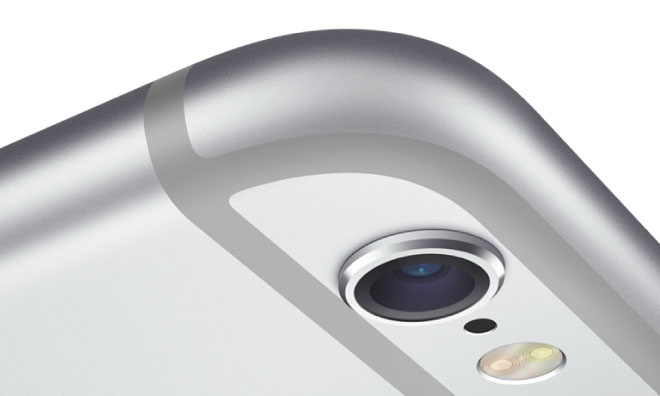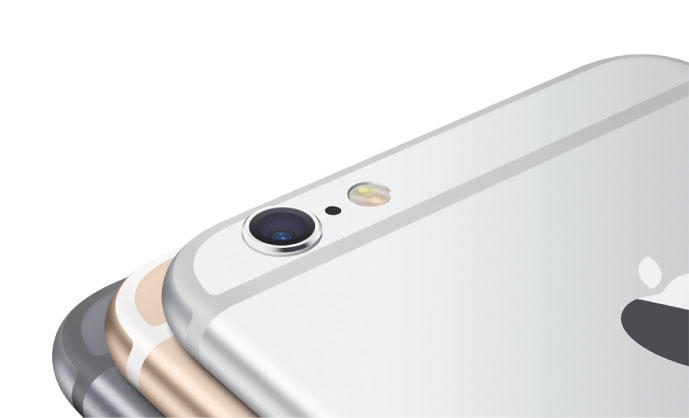With new cameras, Apple's iPhone 6 and iPhone 6 Plus are a boon for mobile photographers
Last updated
With the iPhone 6 and iPhone 6 Plus, Apple added numerous features designed to make life better for users. Photographers are no exception, getting goodies like phase detection autofocus and optical image stabilization — Â AppleInsider took a look at all of the imaging upgrades coming to the next-generation handsets.
Still Imaging
The iPhone has largely derailed the once-booming point-and-shoot camera industry — Â as the old saying goes, "the best camera is the one you have with you," and that has proven to most often be an iPhone. The iPhone 5, 5s, 4S, and 4 hold four of the top five spots for the most popular cameras on photo sharing site Flickr.
Focus Pixels
Both iPhone 6 models feature new Focus Pixels, which is Apple's way of saying that they've added paired focus detection points to enable phase detection autofocus. This technique has been used in digital SLR cameras for years, and — broadly speaking — works by comparing the images received by each detection point in the pair.
If the images on each detection point are the same, the sensor knows that it's focused properly. If the images differ — Â because light reaches the detection points at different angles — Â the image processor can calculate the difference and adjust the lens to compensate, enabling autofocus that Apple says is twice as fast as the iPhone 5s.
Face Detection
With the new A8 chip inside the iPhone 6 series comes an updated image processor. Apple has added dedicated hardware inside the processor for face detection, making it faster, and enhancing blink and smile detection to help the iPhone automatically choose burst photos where everyone is looking at the camera and smiling with their eyes open.
Image Stabilization
Image stabilization is the only area where the cameras in the iPhone 6 and iPhone 6 Plus differ. The iPhone 6 offers software-assisted stabilization, which takes four photos at once — Â each with a short exposure time -Â and combines them into a single image to alleviate noise and motion.
The iPhone 6 Plus, however, adds optical image stabilization. It uses motion data from the handset's gyroscope and M8 motion coprocessor to compensate for hand shake by adjusting the physical position of the lens, and then applies the same software-assisted stabilization as the iPhone 6. This helps most in low-light situations, allowing longer exposures without excessive blur or noise.
Panorama
The new sensor in the iPhone 6 and iPhone 6 Plus has also enhanced the popular Panorama feature introduced in iOS 6. In addition to higher-resolution panoramas — up to 43 megapixels — and dynamic auto exposure, Apple says the new gyroscope in the iPhone 6 series makes for more seamless image stitching.
Video
Apple is particularly proud of the iPhone 6 series's video-shooting bona fides. The marketing site boasts that the "camera that changed photos now does the same for video," and Apple executives were no less boastful during the handset's on-stage introduction.
60 FPS 1080p HD
High-definition 1080p video recording came to the iPhone 5s, but the handset was only capable of recording at 30 frames per second. The iPhone 6 and iPhone 6 plus bump that to 60 frames per second, though users can still choose to record at 30 frames per second if they prefer that speed.
240 FPS Slo-mo
Like high-definition video recording, slow-motion capture appeared alongside the iPhone 5s. Apple has doubled the 5s's 120 frames per second slo-mo capability to 240 frames per second in the iPhone 6 series.
Continuous Autofocus
Apple's new Focus Pixels are also used for video autofocus, and allow the iPhone 6 and iPhone 6 Plus to continuously adjust the autofocus when capturing video. Imagine pointing the iPhone at a distant skyline, and then walking in front of the camera — when enabled, it would automatically adjust the video's focus to the nearer subject, and return to the skyline once they walk out of frame.
Cinematic Video Stabilization
The iPhone 6 series's new Cinematic Video Stabilization is essentially automatic still image stabilization applied to video capture. It's not yet clear whether the iPhone 6 Plus's optical image stabilization system will be used to augment the software stabilization algorithms, and likely will not be until tests are performed following the handsets' release.
Time-lapse
The new Time-lapse feature in iOS 8 allows users to record time-lapse videos with a single tap. Photo intervals will be dynamically selected by the device, and Apple says that it will record for as long as the handset's battery will last.
It's not exclusive to the iPhone 6 series, however — Â it will also available on the iPhone 5, 5c, and 5s after they've been upgraded to the new operating system.
FaceTime HD
The front-facing FaceTime camera got a boost to high-definition with the iPhone 5, and now gains many of the advancements that have hit the rear-facing cameras in the interim. The iPhone 6 and iPhone 6 Plus will ship with a FaceTime HD camera that sports an f/2.2 aperture, as well as a sensor that Apple says will capture 81 percent more light.
Additionally, it can take advantage of the A8's new image processor for face detection and HDR video. Apple has also brought burst mode — up to 10 photos per second — Â and timer mode to the "selfie cam."
 AppleInsider Staff
AppleInsider Staff
















 Amber Neely
Amber Neely
 Thomas Sibilly
Thomas Sibilly

 William Gallagher
William Gallagher
 Malcolm Owen
Malcolm Owen
 Christine McKee
Christine McKee










60 Comments
Slowly, but surely they are disrupting every single industry they decide to invade. Forcing conservative corporate boards to rethink their business models... sony, panasonic, nikon, casio, nokia, garmin, dell, intel, microsoft, VISA, master card, amex, swatch, rolex... and the list goes on. They all have one thing in common at their board meetings - a panicky feeling of being on the defensive. Apple is quietly going about this without even considering what everyone else is doing.
Too bad the resolution has not improved. It has remained fixed at 8 megapixels since the 4s. That's six different phone models with the same resolution: 4s, 5, 5c, 5s, 6 and 6 plus. I realize that image quality matters more than resolution but resolution also matters. They could have squeezed in 12 megapixels by now and still had excellent quality. One other problem they need to solve: The phone should be able to take landscape photos and videos when it is held in portrait orientation. That will get rid of the issue of portrait videos that everyone hates. It is natural to hold the phone vertically but that does not imply we want a portrait aspect ratio. The camera sensor is square so there is no reason at all why it cannot take landscape images and videos from any orientation. Sure give us the option to do portrait if we want (at least for still images) but video should always default to landscape.
[quote name="GrangerFX" url="/t/182232/with-new-cameras-apples-iphone-6-and-iphone-6-plus-are-a-boon-for-mobile-photographers#post_2595826"]Too bad the resolution has not improved. It has remained fixed at 8 megapixels since the 4s. That's six different phone models with the same resolution: 4s, 5, 5c, 5s, 6 and 6 plus. I realize that image quality matters more than resolution but resolution also matters. They could have squeezed in 12 megapixels by now and still had excellent quality.[/quote] Yeah, look at all the higher megapixel camera phones overtaking the iPhones on Flickr... ...oh hang on. At the size of a phone sensor, the compromise with more pixels is more noise to deal with. Apple gets it, HTC gets it, the rest it's more about kudos regarding a number on a spec sheet.
without even considering what everyone else is doing.
Right, because making a 4.7 and 5.5 inch phone is not because of what other people are doing.
[quote name="GrangerFX" url="/t/182232/with-new-cameras-apples-iphone-6-and-iphone-6-plus-are-a-boon-for-mobile-photographers#post_2595826"]Too bad the resolution has not improved. It has remained fixed at 8 megapixels since the 4s. That's six different phone models with the same resolution: 4s, 5, 5c, 5s, 6 and 6 plus. I realize that image quality matters more than resolution but resolution also matters. They could have squeezed in 12 megapixels by now and still had excellent quality. One other problem they need to solve: The phone should be able to take landscape photos and videos when it is held in portrait orientation. That will get rid of the issue of portrait videos that everyone hates. It is natural to hold the phone vertically but that does not imply we want a portrait aspect ratio. The camera sensor is square so there is no reason at all why it cannot take landscape images and videos from any orientation. Sure give us the option to do portrait if we want (at least for still images) but video should always default to landscape.[/quote] Do you print out images in poster sizes? 8 MP is more than enough for 8x10s and below. Don't get me wrong, higher MP would be nice but at what cost: file size. I still have a point and shoot mainly to zoom in farther.